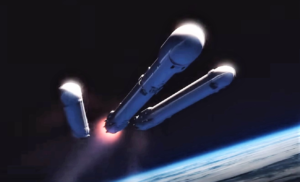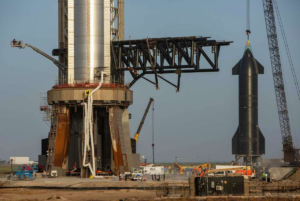
SpaceX’s Falcon Heavy Is About To Launch A Spaceplane!
With four launches already this year, 2023 has been the busiest year yet for Falcon Heavy. Even still, the company has one more scheduled to happen in just a few days to bring the total to 5. Interestingly, rather than your typical payload, this mission will be carrying the U.S. Air Force’s X-37B spaceplane.
Scheduled to happen on December 11th, this mission is quite a big deal thanks to both the payload and launch vehicle being used. The X-37B is a military spaceplane that can perform a host of actions in orbit and can stay there for multiple years before returning for a runway landing. Here I will go more in-depth into this upcoming mission, why it’s using the Falcon Heavy, final mission prep, and more.
Secret Spaceplane

For a while now we had known that Falcon Heavy was scheduled for a mission late this year with the U.S. Air Force named USSF-52. Per usual with military contracts, that was practically all the information we had, and the payload, orbit, etc, were all unknown. That was until a few months ago when they revealed that the X-37B would be the payload.
This was big news as the X-37B has launched quite a bit before, but never on a launch vehicle as powerful as Falcon Heavy. Instead, it would either use the Falcon 9, or an Atlas V. While not provided, this suggests that the spaceplane will be heading to a more distant orbit and needs the power of the Falcon Heavy.
Even though most of this specific mission is kept secret, there are a few statements that provide insight into what to expect. In a statement early last month, the Space Force said, “The mission, designated USSF-52, will conduct a wide range of tests, including operating the reusable spaceplane in new orbital regimes, experimenting with space domain awareness technologies, and investigating the radiation effects on materials provided by NASA.” Interestingly, in addition to the spaceplane, the mission will also include NASA’s Seeds-2 experiment investigating the effects of space-based radiation on plant seeds during a long-duration spaceflight.
Focusing back on the spaceplane, it’s extremely capable and can deploy satellites, host experiments, and a host of other features left unknown. It’s also autonomous which means there are no astronauts onboard. As far as how long it will be in space, its longest mission yet lasted 908 days, which is right around two and a half years.
As of right now, the mission is still scheduled to take place in a few days on the 11th. This was set to happen days prior but was delayed. The launch site is LC-39A at Kennedy Space Center in Florida. It also looks like the center booster will be expended provided additional power during the launch. The two side boosters however will separate and land back near the launch site on the ground. The X-37B weighs around 11,000 lbs (4,990 kilograms), which is well within Falcon Heavy’s capacity no matter the orbit.
All the way back in 2018 is when this mission was awarded to SpaceX. Specifically, in June of 2018, the Air Force released a statement that said, “The Air Force has announced the award of an Evolved Expendable Launch Vehicle (EELV) launch service contract. SpaceX has been awarded a $130 million firm-fixed price contract for launch services to deliver Air Force Space Command (AFSPC)-52 satellite to the intended orbit. The contract provides the Government with a total launch solution for this mission, which includes launch vehicle production, mission integration and launch operations. This mission is planned to be launched from Kennedy Space Center, Florida.” At the time they also commented, “AFSPC-52 is a classified mission projected to launch in late Fiscal Year 2020.”
Falcon Heavy has become quite popular with the military as a good portion of its launches include these government payloads. Just early this year for example the Falcon Heavy launched USSF-67 for a price of around $317 million. It also launched USAF STP-2, and USSF-44. A popular choice due to its high payload capacity and availability. Something we can expect to see a lot more of as time goes on. Looking at the heavy-lift launch vehicle’s schedule, it’s expected to stay busy with consistent launches going into 2024 and beyond. A big improvement from a somewhat slow start.
Busy Schedule

SpaceX has been continuously working toward an increased launch cadence on all of its vehicles. This has been especially obvious with the Falcon 9 as they attempt to launch one every couple of days. While not nearly as frequent, the Falcon Heavy is contributing to this as well with more launches than ever before. To put it in perspective, the first Falcon Heavy mission was in 2018. Between 2018 and the end of 2022, Falcon Heavy launched 4 times in total. In other words, it launched at an average rate of less than once a year. Then 2023 began and already it has launched 4 times this year alone, with a fifth mission just days away.
In reality, there are a few reasons why the Falcon Heavy took so long to start launching frequently. One of the main reasons for this was the success of the Falcon 9. After developing the Falcon 9 SpaceX worked to improve and increase the launch vehicle’s performance. On the other hand, when developing Falcon Heavy, the company was not exactly sure what the Falcon 9 would be capable of. SpaceX was so successful that the Falcon 9 became a lot more powerful than expected. So powerful that a lot of planned missions for Falcon Heavy ended up getting moved to the Falcon 9. In this case, different commercial companies needing a ride to low Earth orbit for example simply did not require the immense payload capacity that the Falcon Heavy offered. Instead, they opted for a less expensive ride on the Falcon 9. SpaceX sells Falcon 9 missions for close to $67 million, whereas a standard Heavy flight goes for around $97 million.
Another reason had to do with a lack of demand. The area where Falcon Heavy really shines is heavy payloads meant for distant orbits. This specific mission profile narrows down the options significantly and mostly includes military launches. Between 2019 and 2022, the need for such a powerful rocket was simply limited. Delays also caused this stretch of no launches to continue. Several planned Falcon Heavy launches were pushed back due to issues with their satellites. USSF-44 for example was originally supposed to lift off in late 2020, but payload problems scuttled that plan. In addition, there were a few competitors that offered comparable capabilities including Arianespace’s Ariane 5 and United Launch Alliance’s Delta IV Heavy, which both launched within that time period.
Lastly, around the time of Falcon Heavy development and lack of launches, SpaceX was ramping up work on Starship. It seems as if the company had a lot of plans but was unsure exactly what each project would be capable of and when. This packed full schedule and various options likely contributed to the lack of launches for various other reasons as well. These different factors however changed significantly in the last year alone.
Starting early next year the pattern of frequent Falcon Heavy launches is expected to continue with the GOES-U launch. In September 2021, NASA awarded SpaceX launch services contract for the geostationary GOES-U weather satellite. Next, the Europa Clipper mission will happen in the third quarter. Here, Europa Clipper will conduct a detailed survey of Europa and use a sophisticated suite of science instruments to investigate whether the icy moon has conditions suitable for life. Key mission objectives are to produce high-resolution images of Europa’s surface, determine its composition, look for signs of recent or ongoing geological activity, measure the thickness of the moon’s icy shell, search for subsurface lakes, and determine the depth and salinity of Europa’s ocean. The mission will fly past Mars and Earth before arriving at Jupiter in April 2030.
You then have the VIPER mission in November, and the NASA Artemis Gateway launch in December. While this mission could very well be delayed due to module progress, it still is not that far away. This launch would include the first elements for the Gateway station as part of the Artemis program, awarded in February 2021. Maxar had already made $27.5 million in payments to SpaceX for the contract to launch the PPE, but later, NASA decided to launch both PPE and HALO together.
Looking at the heavy-lift rocket, Falcon Heavy is composed of three reusable Falcon 9 nine-engine cores whose 27 Merlin engines together generate more than 5 million pounds of thrust at liftoff, equal to approximately eighteen 747 aircraft. As one of the world’s most powerful operational rockets, Falcon Heavy can lift nearly 64 metric tons (141,000 lbs) to orbit. The side cores, or boosters, are connected on the nosecone, the interstage, and on the octaweb. Shortly after liftoff, the center core engines are throttled down. After the side cores separate, the center core engines throttle back up to full thrust. For reusability, the Falcon Heavy first stage is equipped with 12 landing legs (4 on each booster) made of state-of-the-art carbon fiber with an aluminum honeycomb. These features place the Falcon Heavy in a special position depending on the mission requirements.
Conclusion
SpaceX is only a few days away from launching the X-37B spaceplane on top of the Falcon Heavy. This will add to the vehicle’s busiest year yet and mark the 5th launch of 2023. We will have to wait and see how it progresses and the impact it has on the space industry.



